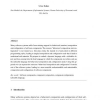Free Online Productivity Tools
i2Speak
i2Symbol
i2OCR
iTex2Img
iWeb2Print
iWeb2Shot
i2Type
iPdf2Split
iPdf2Merge
i2Bopomofo
i2Arabic
i2Style
i2Image
i2PDF
iLatex2Rtf
Sci2ools
CL
2006
Springer
2006
Springer
Tailorable language for behavioral composition and configuration of software components
Many software systems suffer from missing support for behavioral (runtime) composition and configuration of software components. The concern "behavioral composition and configuration" is not treated as a first-class entity, but instead it is hard-coded in different programming styles, leading to tangled composition and configuration code that is hard to understand and maintain. We propose to embed a dynamic language with a tailorable object and class concept into the host language in which the components are written, and use the tailorable language for behavioral composition and configuration tasks. Using this approach we can separate the concerns "behavioral composition and configuration" from the rest of the software system, leading to a more reusable, understandable, and maintainable composition and configuration of software components. Key words: Software components, component composition, component configuration, tailorable language.
Related Content
| Added | 11 Dec 2010 |
| Updated | 11 Dec 2010 |
| Type | Journal |
| Year | 2006 |
| Where | CL |
| Authors | Uwe Zdun |
Comments (0)

